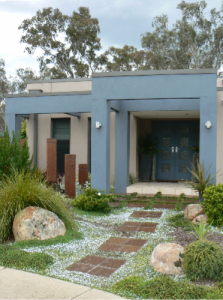Making a dry tolerant garden
- 23
- Mar
I reckon it is time to throw away the rule book and take a fresh look at dry tolerant landscapes.
Opposites like ‘sweet and sour’ might work well together but can’t be both at once. When it comes to gardens that are lush and dry perhaps what seems like a contradiction doesn’t have to be the case.
We might need to break with tradition and bend the rules but that is the exciting part of garden design sometimes. Interestingly it seems like we might have to break not just one set of rules but two- even better!
Gardeners creating lush looking gardens prefer the greenness and abundance of foliage and a style that shouts that everything is healthy and growing. The amount of water required is offset by the coolness and abundance that allows the owner to relax in a garden oasis that stands up and says that this is a place you can live, even when it is forty degrees outside.
By contrast gardeners creating dry gardens have been focused on low water use and creating a style that emphasises the bright Australian sunshine and the light and heat of the climate. Native plants or cacti and succulents predominate along with surfaces of sand or gravel. Dry gardens are a statement by the creator about how we can relate to the world and the environment and how to create a certain aesthetic.
I’m going to stick my neck out and say that these two styles are ideologically at odds with one another. They are opposites and in themselves make an interesting contrast when used together. Geelong Botanic gardens is a great example. If you get a chance it is well worth the trip and is right up there as one of my favourites.
Now that I’ve suggested a radical rewrite of the rules what I am about to suggest is more of an experimental journey rather than a new rule book.
Firstly you have to understand how plants like to grow, provide the right conditions and be wise with how you manage water. These things are just a necessity and if you need help with these than get it. When you get past the basics then dry landscapes start to become more about plant selection and design.
The most powerful tool is how we choose plants and what plants we choose.
I suggest we take a good long look at some new possibilities and mix the following three groups
1. The best of the Australian native plants.
2. The old fashioned rural homestead plants
3. The best of the dry tolerant exotic plants
There are some great Australian natives out there and these are the ones you want. There are others that don’t perform in this area of Victoria so leave them alone. For people that like a lush look there are natives for you.
Old fashioned rural homestead plants. One hundred or more years ago or even only fifty years ago gardens were not watered like they typically are today. We need to step back in time because we left some really good dry tolerant plants behind. Plants from old homesteads were often as tough as the houses they surrounded. Mixing these with the Australian natives is really mixing time and culture
Dry tolerant exotic plants are the third group. I know we have to tread carefully here in case we plant something that becomes a weed and to that end we need to understand a couple of things. One is that Australia is a big place with a huge array of climatic and local conditions and secondly that a weed in one place is not necessarily in another. Be careful giving plants to friends from distant parts and if you like to give pieces of your garden to friends just be very sure it is safe to do so.
Now that we have opened up three areas of plants that traditionally have been thought of as separate and can mix them together I imagine we can create a whole range of garden styles from light, bright and dry looking through to green and lush.
The photos are of landscapes where we have used plants from all three groups in low water use garden areas.




